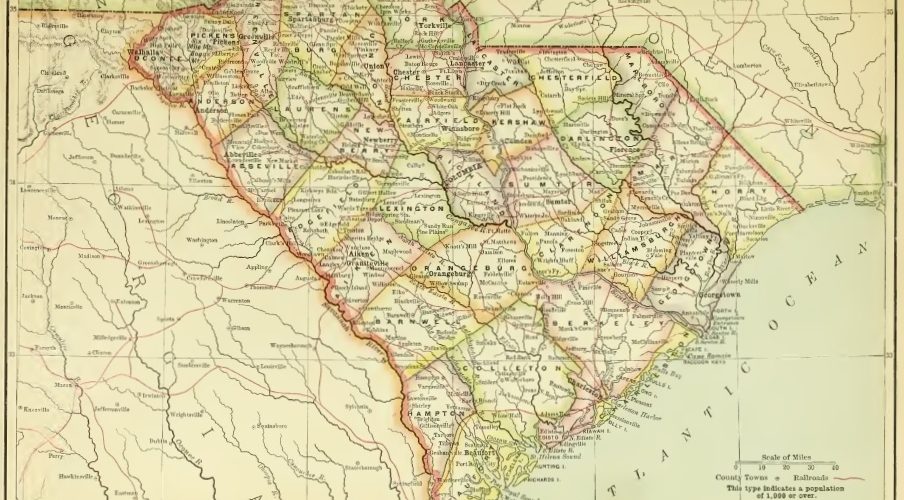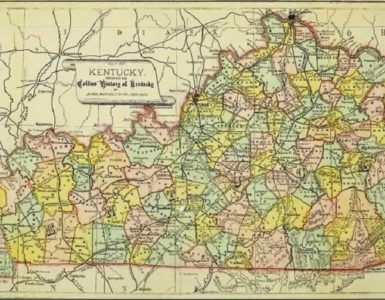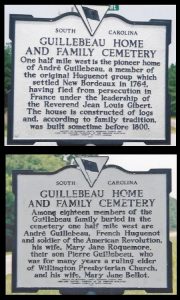 The French Huguenots were one of the persecuted groups that sought religious and political freedom in the colony of South Carolina. Many of the Huguenots that moved to the colonies were poor as well as persecuted, so they pursued new opportunities on the other side of the Atlantic in a new land. The Guillebeau “pioneer home,” said to be one-half mile from the sign is actually located in Hickory Knob State Park in McCormick County. It was moved to the new location around 1983 after the historical marker had been installed near the old location in 1972. The plain, small, and simple frame house of the Guillebeaus has been restored and it is the type of residence one would expect for pioneers living in a remote area.
The French Huguenots were one of the persecuted groups that sought religious and political freedom in the colony of South Carolina. Many of the Huguenots that moved to the colonies were poor as well as persecuted, so they pursued new opportunities on the other side of the Atlantic in a new land. The Guillebeau “pioneer home,” said to be one-half mile from the sign is actually located in Hickory Knob State Park in McCormick County. It was moved to the new location around 1983 after the historical marker had been installed near the old location in 1972. The plain, small, and simple frame house of the Guillebeaus has been restored and it is the type of residence one would expect for pioneers living in a remote area.
Jean Louis Gibert was born to Pierre and Louise Guy Gibert on June 29, 1722. He was the leader of the group of immigrants that formed the New Bordeaux community. He left France for England in 1763 where he arranged transportation to America for himself and other Huguenots. The ship carrying them set out from Plymouth and then made port in Charleston after a difficult and extended voyage. In August 1764 the Huguenots came upon the land that would become their new home, but Rev. Gibert had remained in Charleston for some time before joining the colonists. When the French pioneers arrived at their destination they built what might be called a city hall at the heart of their village, something similar to a meeting house in New England. The town was laid out in half-acre lots where the French pioneers constructed their simple homes, a church, and developed their farms and community. Due to Gibert’s remaining in Charleston his associate, Rev. Boutiton, was the first minister for the congregation in New Bordeaux.
One of the economic endeavors undertaken by the residents of New Bordeaux was, as the historical marker comments, making silk. In the eighteenth century silk was an established industry in France. The Huguenot colonists grew worms and processed the silk fibers to earn their livings. Silk processing involved less labor than other types of textiles because each cocoon yielded a very fine fiber of up to 1,000 yards in length. Several of the tiny fibers could be spun together to produce a thread, and then the thread was spooled for weaving. According to a comment by George Howe citing the South Carolina Gazette, August 3, 1765, Jean Louis Gibert worked for Gabriel Manigault who was the owner of the plantation named “Silk Hope.” One year, under the direction of Gibert, the plantation produced six-hundred-thirty pounds of cocoons.
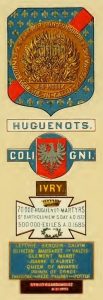 The historical marker also mentions that Pierre Guillebeau was an elder in the Willington Presbyterian Church for many years, which shows that he made the transition from his Huguenot background to a Presbyterian Church. Jon Butler’s conclusion in his The Huguenots in America observed that “everywhere Huguenots settled they disappeared. By 1750 Huguenots no longer existed as a significant religious, national, or ethnic minority in most of their places of exile; by 1800 they had disappeared in all of them” (p. 211). Though “all” should probably be replaced by “very many” and his ending date extended, the point is that the Huguenots established themselves, survived as a religio-ethnic community for a time, and then they faded until the only extant Huguenot Church is the one currently in Charleston. The New Bordeaux community was the last Huguenot community to be organized in South Carolina before the American Revolution, and as Butler noted, it too disappeared. Butler points to factors such as a loss of national identity and a failure of the American French Protestants to maintain their cohesion as causes for the demise of the Huguenots. However, are these bad things? Could it be that American Huguenots recognized their common doctrinal commitment with Presbyterian and Reformed churches and saw no reason to continue their particularly French churches? In the case of the Huguenots that founded New Bordeaux, their descendants joined churches in the area of Abbeville and McCormick Counties and some cemeteries in the area have a number of French surnames inscribed on the grave stones. Instead of seeing the demise of American Huguenots as something negative, it could be viewed positively as a demonstration of their commitment to church unity with those of common theological commitments.
The historical marker also mentions that Pierre Guillebeau was an elder in the Willington Presbyterian Church for many years, which shows that he made the transition from his Huguenot background to a Presbyterian Church. Jon Butler’s conclusion in his The Huguenots in America observed that “everywhere Huguenots settled they disappeared. By 1750 Huguenots no longer existed as a significant religious, national, or ethnic minority in most of their places of exile; by 1800 they had disappeared in all of them” (p. 211). Though “all” should probably be replaced by “very many” and his ending date extended, the point is that the Huguenots established themselves, survived as a religio-ethnic community for a time, and then they faded until the only extant Huguenot Church is the one currently in Charleston. The New Bordeaux community was the last Huguenot community to be organized in South Carolina before the American Revolution, and as Butler noted, it too disappeared. Butler points to factors such as a loss of national identity and a failure of the American French Protestants to maintain their cohesion as causes for the demise of the Huguenots. However, are these bad things? Could it be that American Huguenots recognized their common doctrinal commitment with Presbyterian and Reformed churches and saw no reason to continue their particularly French churches? In the case of the Huguenots that founded New Bordeaux, their descendants joined churches in the area of Abbeville and McCormick Counties and some cemeteries in the area have a number of French surnames inscribed on the grave stones. Instead of seeing the demise of American Huguenots as something negative, it could be viewed positively as a demonstration of their commitment to church unity with those of common theological commitments.
Barry Waugh
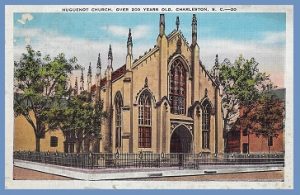
The Huguenot Church, Charleston, South Carolina
Note—It could be that Rev. Gibert’s working for Manigault raising silk worms shows that he was a silk farmer in France. Silk farming was commonly practiced in France, so for a successful businessman like Manigault to employ Gibert to oversee his business, Gibert must have had some experience with silk. There is on Presbyterians of the Past a biography of David Xavier La Far, 1826-1897, who was a pastor of the Huguenot Church in Charleston.
Sources—A. H. Hirsch, The Huguenots of Colonial South Carolina, 1928, reprint, Columbia: University of South Carolina Press, 1999. Jon Butler, The Huguenots in America: A Refugee People in a New World Society, Cambridge: Harvard University Press, 1983. George Howe, History of the Presbyterian Church in South Carolina, 2 vols. Columbia: Duffie & Chapman, 1870; Columbia: W. J. Duffie, 1883. Denis Diderot, A Diderot Pictorial Encyclopedia of Trades and Industry, vol. 2, New York: Dover Publications, 1987; this book includes a selection of plates from Diderot’s eighteenth century work, L’Encyclopédié, ou Dictionnaire Raisonné des Sciences, des Arts et des Métiers. The image of Huguenot Church postcard was scanned from the author’s copy.


